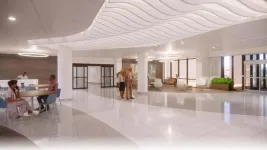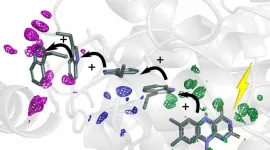(Press-News.org) The Blood Cancer Healing Center, located at 3229 Burnet Avenue in Uptown Cincinnati, is poised to redefine care standards by offering comprehensive patient support and innovative treatments under one roof. With clinical services opening as part of a phased approach in the summer of 2024, this state-of-the-art facility will address the critical needs of the 1.6 million individuals affected by blood cancers, such as leukemia, lymphoma and myeloma, annually in the U.S. Other spaces within the facility are scheduled to open in 2025.
Care will be given around the clock in both the inpatient and outpatient settings, featuring 30 inpatient beds, outpatient and infusion clinics, survivorship and supportive services, and a dedicated clinical trials unit. Novel therapies and other treatments, including cellular and stem cell therapies, will expand access to cutting-edge options for patients.
The Center’s vision also includes additional support for patients through integrative health therapies, including group wellness spaces. These services will become available at a later date, to support patients at every stage, mitigate side effects during treatment, and enhance overall quality of life.
Driven by the visionary leadership of John C. Byrd, MD, a University of Cincinnati Cancer Center physician-researcher who is one of the leading figures in blood cancer research in the world, the Center embodies a whole-person approach to healing. Dr. Byrd's pioneering work, including his contributions to eliminating chemotherapy for chronic lymphocytic leukemia patients, underscores the Center's commitment to personalized care and breakthrough treatments. His work has changed the face of blood cancer treatment for patients globally.
“Research advancements for many forms of blood cancer are giving new life to patients. You can now survive years past a blood cancer diagnosis, managing it as a chronic illness. The Blood Cancer Healing Center supports this new life for patients by bringing all the needed supportive services and pioneering research together to deliver personalized care in one therapeutic environment,” said Dr. Byrd, who also serves as the Gordon and Helen Hughes Taylor Professor and Chair of the Department of Internal Medicine at the UC College of Medicine.
Additionally, the Center's design, inspired by Dr. Byrd's legacy of innovation, will foster enhanced collaboration between researchers and industry partners. With a dedicated laboratory space set to open in 2025, the Center will serve as a focused environment for high-impact discoveries and translational research in blood cancer treatment.
“As a collaboration among the University of Cincinnati College of Medicine, UC Health, and Cincinnati Children's, the University of Cincinnati Cancer Center sets a higher standard for cancer care that has made Cincinnati the place for new research investments and the nation's top physician-scientists,” stated Andrew Filak, MD, Christian R. Holmes Professor and Dean of the UC College of Medicine. “Under the leadership of our exceptional faculty, the innovative Blood Cancer Healing Center will attract top researchers, improve patient care, and expand education and prevention programs that ultimately improve quality of life in Cincinnati and beyond.”
The 212,000-square-foot facility marks a major milestone for the University of Cincinnati Cancer Center, whose 256 clinicians and researchers aim to elevate cancer research and care standards regionally and nationally. When finished, the Blood Cancer Healing Center expects to employ over 200 full-time employees, including clinical and supportive staff.
Backed by a combined investment of $131 million from the University of Cincinnati and UC Health, other funding sources include operational dollars, financing, philanthropic and community support, including New Markets Tax Credits secured through Uptown Consortium.
The Blood Cancer Healing Center is a collective commitment to providing unparalleled support and hope for patients and families grappling with blood cancers.
To discover more, visit uchealth.com/cancer. For blood cancer patients looking to learn more, call 513-585-UCCC. For physicians and researchers seeking additional information, visit cancer.uc.edu.
Additional Comments from Leaders
“The center was designed with input from patients and their caregivers, with access to the newest therapies and supports in one physical space, making healing possible for the mind, body and spirit and advancing research for the next cure for this disease,” said Cory Shaw, president & CEO of UC Health.
“The University of Cincinnati Cancer Center’s new Blood Cancer Healing Center will be a home for newfound innovation,” said Neville G. Pinto, PhD, president of the University of Cincinnati. “This space connects all the integral partners that work together to lead high-impact discoveries in cancer research.”
“The Blood Cancer Healing Center is an important part of the comprehensive care being amplified and coordinated within the University of Cincinnati Cancer Center. Cincinnati Children’s is proud to be a part of the University of Cincinnati Cancer Center as we work together to care for and cure cancers affecting people of all ages, both here and around the world,” said Steve Davis, MD, MMM, president & CEO of Cincinnati Children’s.
# # #
About the University of Cincinnati Cancer Center
Leveraging cutting-edge research, active community engagement, and a dedication to training the next generation of cancer researchers and providers, the University of Cincinnati Cancer Center is working to reduce the incidence, disparities, and societal consequences of cancer. The Cancer Center forms a formidable coalition of expertise boasting a membership of over 250 researchers and physician-scientists from the University of Cincinnati, a Top 35 public research university, UC Health, the region’s academic health center, and Cincinnati Children’s, the nation's top ranked pediatric cancer care and overall children’s hospital. With a robust portfolio of peer-reviewed cancer research grants, the University of Cincinnati Cancer Center stands at the forefront of discovering innovative approaches for cancer prevention, detection, diagnosis, treatment and survival. Learn more at cancer.uc.edu.
END
A new Tulane University study published in Nature Communications offers a glimpse into the possible impact of climate change on coastal wetlands 50 years or longer into the future.
Scientists are usually forced to rely on computer models to project the long-term effects of rising seas. But an unexpected set of circumstances enabled a real-world experiment along the Gulf Coast.
An extensive network of nearly 400 monitoring sites was established along the Louisiana coast after hurricanes Katrina and Rita. Then the ...
A consortium of Birmingham researchers, clinicians and industry partners has received a second £1.1m award from the National Institute for Health and Care Research (NIHR) for a three-year study supporting the further development of a novel device that could revolutionise the clinical management of anal fistula.
In this intrusive and embarrassing condition, sufferers experience daily discomfort and smelly discharge from a tunnel between the bowel and skin around the anus. It affects mostly young people and has a significant impact on employment and family life due ...
From today, patients and doctors at Amsterdam UMC's Heart Centre can make use of the app HartWacht (HeartGuard, in English) to supplement their care. Through the use of a small measurement instrument, around the size of a cereal bar, and a mobile app, patients can now have their blood pressure and arrythmias monitored at home. This means that patients need to visit their cardiologist less frequently. For doctors, this means they have more precise measurements and can act quicker where necessary. A ''win-win'' in the eyes of Michiel Winter, cardiologist at Amsterdam UMC and leader of this project.
"HartWacht ...
Cells need energy to function. Researchers at the University of Gothenburg can now explain how energy is guided in the cell by small atomic movements to reach its destination in the protein. Imitating these structural changes of the proteins could lead to more efficient solar cells in the future.
The sun’s rays are the basis for all the energy that creates life on Earth. Photosynthesis in plants is a prime example, where solar energy is needed for the plant to grow. Special proteins absorb the sun’s rays, and the energy is transported as electrons inside the protein, in a process called charge transfer. In a new study, researchers show how ...
Body language and the understanding thereof is a crucial part of communication. It is often assumed that humans can innately recognize other’s emotions, but there is growing evidence that the ability to decipher these emotions is not instinctive but shaped by people’s culturally shared understanding of emotions.
A team of scientists in the US decided to investigate how cultural upbringing and access to emotion category words, which categorize and facilitate access to a complex set of emotional ideas, experiences, and responses ...
WASHINGTON – A new Environmental Working Group peer-reviewed study has found chlormequat, a little-known pesticide, in four out of five people tested. Because the chemical is linked to reproductive and developmental problems in animal studies, the findings suggest the potential for similar harm to humans.
EWG’s research, published February 15 in the Journal of Exposure Science and Environmental Epidemiology, tested the urine of 96 people for the presence of chlormequat, finding it in 77 of them. EWG summarized the findings in an article published on its website.
“EWG’s new study on chlormequat ...
Mothers are less likely to take antidepressants if their own parents and parents-in-law are healthy and live close by– a new study finds.
On the flip side of the coin, antidepressant use was highest in mothers whose parents and parents-in-law were elderly, in poor health, and lived far away – possibly due to the stress caused by needing to care for and support older grandparents instead of receiving help from them.
The findings of this new longitudinal study which tracked 488,000 mothers of young children between 2000-2014 are published today in the peer-reviewed journal Population Studies.
“Previous studies have consistently shown that younger grandparents in good ...
KEY TAKEAWAYS
The majority of the world’s people live in what are known as “blood deserts,” areas in which the clinical need for blood components cannot be met in at least 75% of cases.
A global coalition of experts led by researchers from the Brigham identified urgent steps that can be taken by health systems to improve access to blood until longer term strategies are established
Billions of people live in parts of the world that are so remote from the nearest hospital facility with a functioning blood bank that they are termed “blood deserts.” Researchers from Brigham and Women’s Hospital, a founding member of the ...
Walking or jogging, yoga, and strength training seem to be the most effective exercises to ease depression, either alone or alongside established treatments such as psychotherapy and drugs, suggests an evidence review published by The BMJ today.
Even low intensity activities such as walking or yoga are beneficial, but the results suggest that the more vigorous the activity, the greater the benefits are likely to be.
The authors stress that confidence in many of the findings remains low ...
Securing suitable childcare for the irregular and long working hours demanded by a medical career is a crippling financial burden and a draining source of stress for doctor parents, reveals an exclusive snapshot survey by The BMJ today.
Some doctors have resigned or are considering resigning, others have changed specialities in the hope that it gives them more flexibility, and yet more altered their plans to have children as a result, reports health journalist Erin Dean.
The BMJ Childcare Survey ran on bmj.com from 16 to 30 November ...


